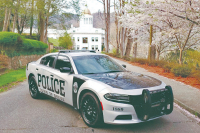One-night trips into the Smokies
 For day hikers who want to take the next step or for a seasoned backpackers who can’t find the time or resources to make that long trip this year, outdoor author Jim Parham is offering up the solution that is just right: the short backpacking trip.
For day hikers who want to take the next step or for a seasoned backpackers who can’t find the time or resources to make that long trip this year, outdoor author Jim Parham is offering up the solution that is just right: the short backpacking trip.
His recently published book, Backpacking Overnights, details 50 one- and two-night trips in the Carolina Mountains. The premise of the book, and Parham’s philosophy, is that backpacking should be easy, accessible and fit into the schedule of the 9 to 5 working stiff.
Gripped by history: A one-woman mission to trace Waynesville’s early roots takes on a life of its own
 Lately, it seems Ann Melton was born in the wrong century.
Lately, it seems Ann Melton was born in the wrong century.
During the past two years, Melton has spent more time living in the late 1800s — the days when boarding houses and hitching posts lined Waynesville’s Main Street, when general stores still had butcher counters and bartering was a way of life — than the comparatively humdrum trappings of the 21st century.
Waynesville publisher hopes to capitalize on niche market
 Covering everything from bugs’ butts and food for animals to animal tongues and eyes, EarlyLight Books has found a special section of the book world to occupy — science books for toddlers.
Covering everything from bugs’ butts and food for animals to animal tongues and eyes, EarlyLight Books has found a special section of the book world to occupy — science books for toddlers.
Early birds to line up for first grabs at Haywood book sale
 By Peggy Manning • Correspondent
By Peggy Manning • Correspondent
Dave and Judy Russell pride themselves on being among the first in line at the annual book sale sponsored by the Friends of the Library in Waynesville.
When it comes to books, here is what women want
“What do women want?”
During the month of December, Sigmund Freud’s famous question haunts the minds of many men. Unlike the perturbed analyst, however, men face a more practical and restricted version of this question, specifically: “What do women — mothers, sisters, friends, lovers, wives — want to find under the tree on Christmas morning?”
On the Saturday following Thanksgiving, I landed in Asheville’s Barnes and Noble, where I meandered through the best-sellers and gift books, seeking for review books that might appeal to women at Christmas. A quarter of an hour had expired when three successive thoughts occurred: 1) I wasn’t sure what books were popular with women this season; 2) I was in a large bookstore; and 3) the bookstore was full of women interested in books. Why not simply ask them for their recommendations?
Here a natural caution exerted itself. Given the legions of sexual oddballs in our society, aware that I myself had reached the cusp of that age when someone might mistake me for a “Dirty Old Man,” and fully cognizant of the fate of those adventurers who accost their subjects with rash familiarity — think of the “Crocodile Hunter” and his grisly end — I deemed it prudent to take certain precautions in my approach to female shoppers and staff. I would avoid any female who looked anywhere near the age of 18. I would quickly identify myself and explain that I was writing a book review column for The Smoky Mountain News. I would ask only for first names and then inquire as to their recommendations.
This plan worked, as the adage goes, like a charm. I survived with all appendages intact and learned a few things about the literary tastes of the female of the species. Gentlemen, here is a summary of my time in that jungle of print, paper, and perfume.
Emily, the youngest of my subjects — I would place her in her mid-20a — was holding a copy of In Search of the Knights Templar: A Guide to the Sites of Britain. “I’m buying it for myself,” she explained. “I’d like to go to Britain in a few years.” But what would she give to her friends? “Well, I like Stephen King. I just started reading him. And Charles Dickens. To Kill A Mockingbird is one of my favorite all-time books.”
After duly noting Emily’s choices, I found Donna seated on the carpeting of the New Age aisle with six or eight books stacked at her knees. She reminded me that the key to purchasing books for presents was a familiarity with the recipient’s interests. “For example, I like books on spirituality,“ she said, pointing to the piled volumes, “and I’m looking at these books for myself. But if I buy for friends I mostly go for cookbooks or biographies.” (Here I will mention that I had earlier turned over the pages of Tupelo Honey Café: Spirited Recipes from Asheville’s New South Kitchen. Written by Elizabeth Sims and Chef Brian Somoskus, this colorfully illustrated volume would make a fine gift for anyone with an interest in cooking — or for that matter, in eating).
Susie, a clerk in the store, noted that best-sellers were always popular. “The Help is popular this year, too,” she said. “That book is older, but we sell a lot of them. And children and teens are now asking for their books for Christmas by title, which helps out their parents a lot with shopping.”
So what were young women reading this year?
“They still seem to enjoy paranormal romances, like the Twilight books,” she said. (Here I wanted to comment that my own encounters with romance had all smacked of the paranormal, but restrained myself). “Biographies are popular, too, for women and men as gifts,” she said.
Andrea, one of the store’s managers, prefaced her comments by saying “My reading tastes probably aren’t typical of a lot of female readers,” a remark made by every woman to whom I spoke. Andrea liked true-crime books and had just finished Jay Cee Duggard’s A Stolen Life: A Memoir. “A lot of our female customers enjoy historical fiction. A lot buy religious fiction.” (I had noticed the large section of Christian novels on the second floor). “Vicky Lane and Sarah Allen are two local authors who are popular with our female readers. In terms of the best-sellers, Patterson and Sparks appeal to women.” Later I found the new books by both authors — Patterson’s The Christmas Wedding and Nicholas Sparks’ The Best of Me — displayed prominently both on the store’s front table and on the best-seller aisle.
Barnes and Noble also features The Nook, its answer to Amazon’s electronic book-reader, the Kindle. When I asked Kate, one of the Nook sales staff, whether more men or women bought the Nook, she thought that purchases ran about 60 to 40 in favor of women. “Women who like reading like the Nook. In fact, people from ages 6 to 90 love the Nook,” she added. “Yesterday we sold $17,000 worth of equipment, and that doesn’t include the add-ons.”
There you have it, gentlemen, a feast of print: electronic book devices, best-sellers, cookbooks, biographies, novels of romance. Keep in mind, too, that these are only the hors d’oeuvres. Bookstores large and small serve a buffet aimed at many tastes.
Poor Dr. Freud. Maybe all he had to do to find an answer to his question was ask.
Murder, sex and celebrities — 1920 style
Well, kind hearts, as they used to say back in the Jazz Age, this one is “the bee’s knees.” Set in the roaring 1920’s, Ron Hansen’s new novel is based on the sensational 1927 murder trial and execution of Ruth Snyder and her weak-kneed accomplice, Judd Gray. Viewed from the jaded present age where we have become accustomed to media coverage of serial killers, bizarre mutilations and the over-hyped details of the Casey Anthony murder trial (which is still dominating the news), the details of this crime by two inept, foolish lovers seems sordid ... but unremarkable. Yet, there is something here that caught the morbid attention of America in what became known as “The Trial of the Century.” What was it?
In addition to turning the courtroom trial into a media circus that dominated newspaper headlines for six months, New York’s Queens County drew an audience of thousands that packed the courtroom, the halls and the surrounding grounds and streets. Celebrities managed to acquire seating up close to the action. New York Gov. Al Smith; the Rev. Billy Sunday; evangelist Aimee Semple McPherson; historian Will Durant, comedian Jimmy Durante; director D. W. Griffith; songwriter Irving Berlin; columnist Fannie Hurst; and playwright Damon Runyon came each day - all eager to share their opinions and moral judgments in paid interviews with the media. Aimee preached a stirring sermon about “sex love” and “red-hot cuties.” Noted playwright Willard Mack noted that, as theater, the trial lacked direction. “The plot was weak and most of the participants were stupid.” However, each performance was standing room only.
And share them, they did. Each day, for the duration of this amazing trial, writers, gossip columnists, early advocates of Freudian psychology and even politicians and comedians made daily comments about how the Ruth Snyder affair was a lurid fable about the dangers of the New York lifestyle. As the testimony shifted from prosecution to defense, Ruth and Judd found themselves described first as tragic victims of a doomed passion and then as coarse and shallow alcoholics who were motivated totally by greed (Ruth had secretly taken out a $95,000 insurance policy on her husband, Albert’s life.)
When the sordid details of their “love nest” were revealed — a lavish room at the Waldorf-Astoria where this carnally imaginative couple conducted a year-long tryst — the moral pundits of New York were finally shocked. Drunken orgies complete with bootleg whiskey and room-service banquets ... and all of it recorded in Ruth’s diary, a document so lewd and explicit with sexual details that the court finally ruled against allowing it to be read in court.
After Ruth Synder turned against Judd Gray, testifying that she had been a reluctant participant in Albert’s death (bludgeoned to death in his bed with a window sash), the media coverage gradually became vicious. Judd was no longer described as “a debonair, educated distributor of women’s lingerie” but as “a weazened little corset salesman.” Ruth was no longer extolled as a “wowser” with “China-blue eyes crackling sparks,” but as a “blond fiend, a vampire” and a “spider woman” who had revealed herself to be “a shallow-brained pleasure seeker who is accustomed to unlimited self-indulgence.” Finally, when Ruth’s diary revealed that she had attempted to murder her husband a half-dozen times before she finally solicited Judd’s reluctant assistance, the last vestiges of sympathy vanished. The jury was out less than 90 minutes.
Reduced to its basics, the Ruth Snyder/Judd Gray murder trial has a tawdry simplicity. There are no heroes or heroines in this triangle. Ruth, unhappily married to a moderately successful magazine editor, suffered from neglect and physical abuse. Treated with public contempt by her husband, she attempted to fill in the vacuums in her life with a frenzied self-indulgent life style. Broadway shows, beach parties, shopping binges with her 9-year-old daughter ... and flirting with every “beach sheik” in sight.
Judd Gray’s life seems a duplicate of Ruth’s. Unhappily married but a devout parent to his indifferent daughter, Gray is reputed to be a successful salesman with a genuine love of music and the arts. Unfortunately, he is a seasoned alcoholic, who, according to his own admission, never falls asleep at night, but “passes out.” In the morning, he does not wake up, but merely “regains consciousness” to continue to drinking.
From their first encounter, this “jazz couple” seem to be hopelessly drawn to each other; their wild roller coaster affair is an exhilarating rush to destruction. Yet, they are a product of their time. Ruth quips like Mae West, an actress she admires: “Better to be looked over than overlooked,” she says when sees admiring males looking her over. She sings Irving Berlin songs, peroxides her hair a vivid blonde and knows all the current dances. She is, after all, “a real jazz baby.” Judd quotes the classics, attends the theater, affectionately refers to Ruth as “Momsie,” and ponders the moral issues explicit in D. W. Griffith’s movie, “An American Tragedy” (which concerns a murder that has some remarkable parallels to poor Albert Snyder’s demise).
As for Albert Snyder, it would be difficult to find a less sympathetic victim. Arrogant, self-indulgent and given to episodes of surliness and bad temper, he had few friends. Although an enthusiastic party-goer, he frequently insulted his peers and had a reputation for picking fights. Ironically, the autopsy performed on Albert revealed that he was suffering from alcoholic poisoning and if Ruth and Judd had not succeeded in beating his brains out with a window sash, he may have died that night from the effects of bootleg whiskey.
In reviewing the case, many legal pundits conclude that this was “a murder by clowns,” carried out by an almost child-like ineptitude. Certainly, the trial was badly handled by the defense. Given the fact that there was a plentiful supply of black-hearted villains and gory Capone-era slaughters, the public’s passionate demand for the death of these two poor sinners seems excessive. Why? Hundreds of worse killers have walked away, or ended up with a life sentence. Why execute Ruth and Judd?
Perhaps their mistake was candor. Ruth’s diary treated both the murder and the erotic details of their love affair with a kind of joyful zest and abandon. Certainly, the secret pleasures they enjoyed were not unknown in New York’s decade of decadence, but perhaps what was unforgivable was to record everything with such enthusiasm and frankness. Ruth seemed to glory in carnal details; poor Judd was devastated by guilt, which meant that he enjoyed the experience even more.
Ruth and Judd did not die well. A Wild Surge of Guilty Passion concludes with a harrowing account of the executions. Ruth approached the electric chair with fear and trembling, and had to be forced to sit. A few moments later Judd Gray managed to walk under his own power and take his place. Both suffered embarrassment regarding their coarse prison garments and the tonsure-shaved circles on their heads. Following their execution, the burned and blistered bodies of the two lovers were placed on storage shelves awaiting burial ... their nerveless hands, scant inches from each other.
A Wild Surge of Guilty Passion by Ron Hansen. Scribner, 2011. 256 pages.





